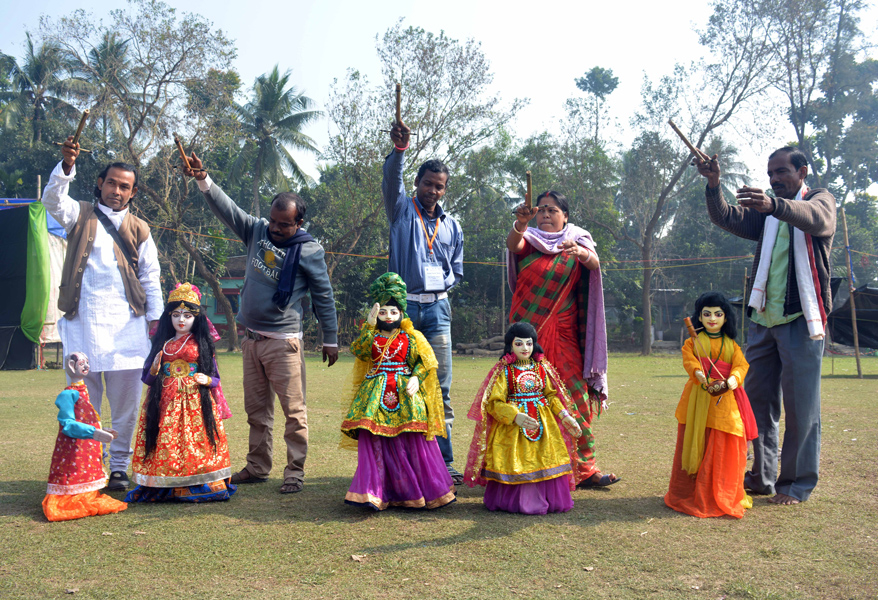Seventy-two-year-old Jagbandhu Singh is both happy and sad. He feels dejected that puppetry has lost its shine in the glamourous world of television and social media, even as he remembers the heydays of the glorious traditional art when he was flooded with shows and hardly had time to spare. He is saddened that many artists sat idle without work for months, finding it difficult to arrange even one square meal a day.

But his eyes light up with hope as he realises that slowly puppetry is gaining recognition due to the efforts of the West Bengal government and social enterprises who are extending patronage to the art.
Jagbandhu resides in Muragacha Colony in West Bengal’s Nadia district, the birthplace of puppetry art in the State. After the partition of India and Pakistan in 1947, most of the puppeteers relocated to villages in Nadia district.
“Our ancestors had moved from Pakistan after independence. Puppetry used to be their livelihood there and they continued the vocation when they arrived here too,” he says, relating the history told by his parents.
We also perform shows based on themes such as adhering to traffic rules, importance of wearing helmets, literacy etc.
Puppetry in West Bengal, which finds mention in the medieval folk ballads of undivided Bengal, is commonly called putul naach (doll dance). Traditional forms of the art include rod and glove puppets. String puppetry, which is nowadays in practice, was a later import, says Jagbandhu. String puppets, originally manipulated with string and also with wire, are mostly found in Nadia.
Until two decades ago, almost every household in Muragacha was involved in puppetry, ranging from making puppets to giving performances. But the advent of television, coupled with the waning interest of people, rang the virtual death bell for the art.
“There were around 380 families in the village that were involved in puppetry in the 1980s. The artists were in great demand and spent around six months every year outside the village giving performances across the State and even outside. We normally performed at least 25–30 shows every month. The income was also good and we didn’t have to look for any alternative forms of livelihood,” says Amolya Rai, a puppetry artist.
But things began to change from mid-1990s when other forms of entertainment emerged both in urban and rural belts of the State., “We started losing work as people began to switch to television. The cable network proved to be the last nail in the coffin. People lost interest in puppetry despite the fact that it was devoid of vulgarity and always gave a social message to the children,” he added.
We started losing work as people began to switch to television. The cable network proved to be the last nail in the coffin.
Now, most of the puppeteers are working as labourers; some have even migrated to other States, looking for alternate livelihood.
However, the State government is taking efforts to revive the dying art. A series of shows were held during the winter months and Bangla Natok, a social enterprise has been actively supporting the artists to conduct shows in other cities and villages.
Ranjan Rai, another artist, says that children in cities are interested in watching the puppet shows as “they have never seen anything like this before. We are also shortening the duration of the shows to keep the interest alive.”
Some modern adaptations are also being made to mythological stories such as the Ramayana, Mahabharata and Panchatantra Tales, to sensitise people on various social issues. “We also perform shows based on themes such as adhering to traffic rules, importance of wearing helmets, literacy etc,” he added.
Amitava Bhattacharya, the founder of Bangla Natok, says that puppetry has a great scope and wider reach among everybody, especially children. “We started working with puppeteers about two years ago and have conducted workshops with about 80 artists and then linked them to various festivals.” At least 30 of them have visited few cities outside Bengal, two artists had performed at the Gannat Festival in France in 2015. Puppet shows were held in various places during Durga Puja and in school programmes. “We, along with the State government, are also conducting a three-day puppetry fair every year in December to promote the art. It has helped us to attract the younger generation.”
It is time to revive the culture which has been slowly getting lost in the noise of technology and modernisation.








